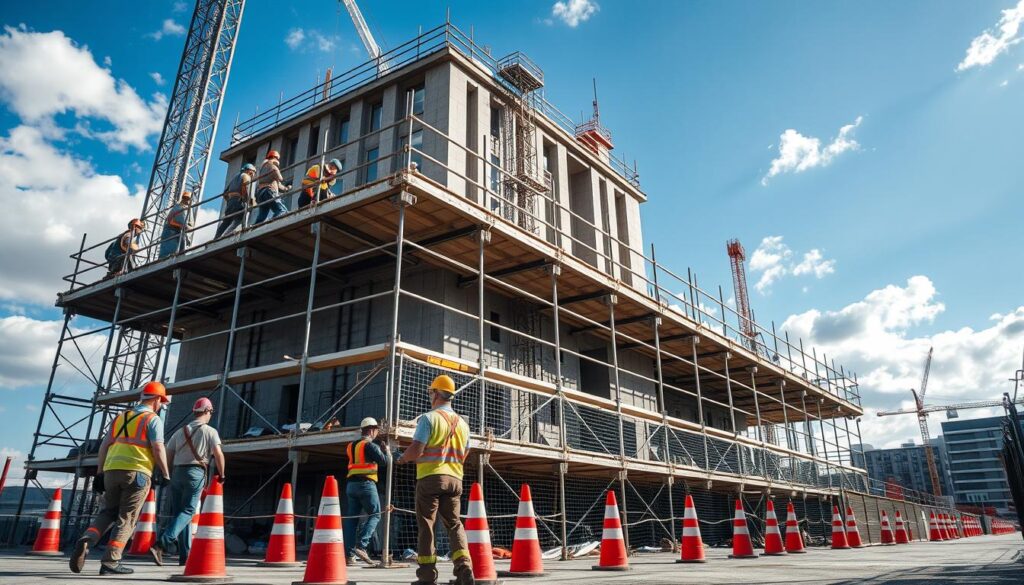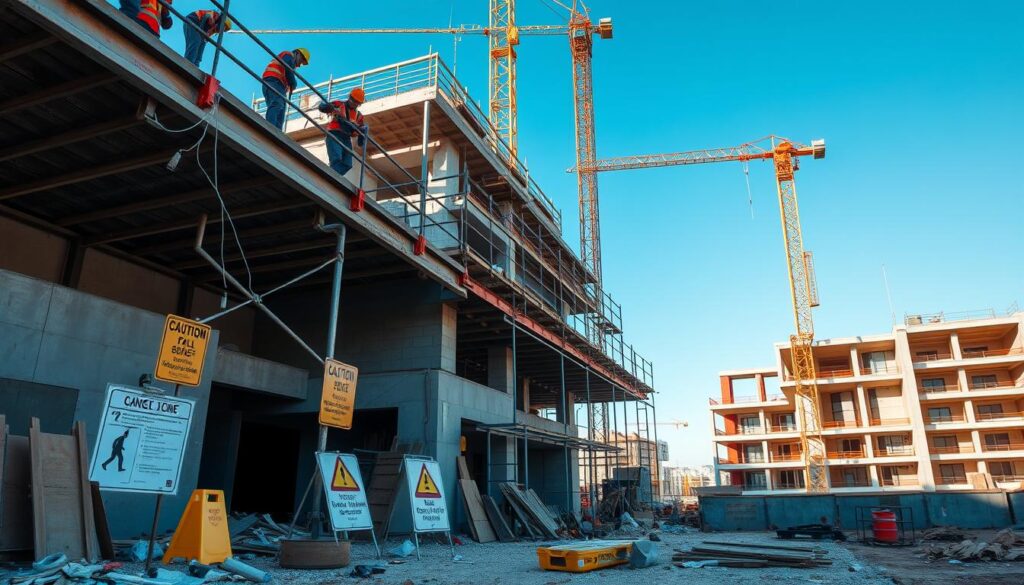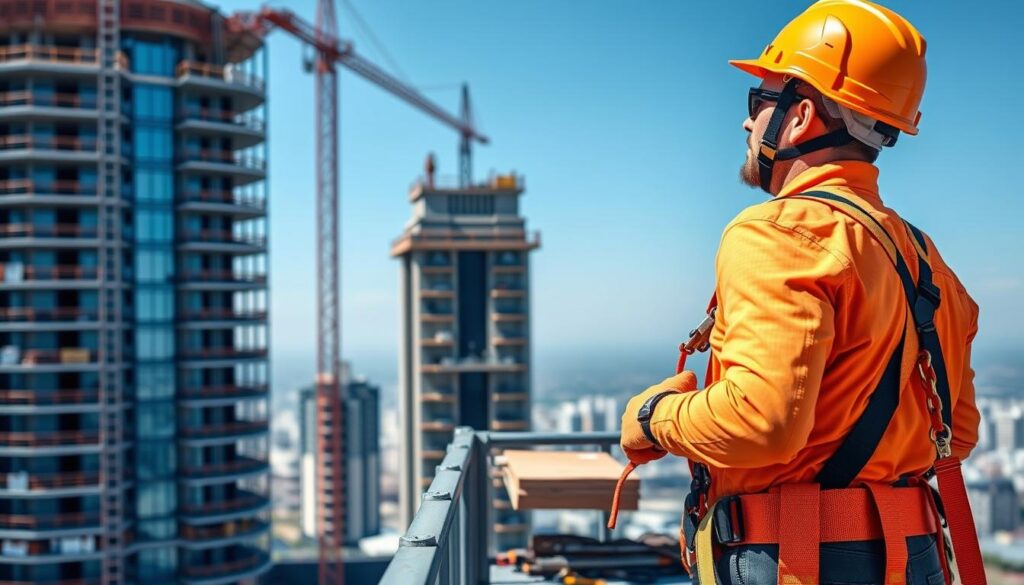As a seasoned construction professional, I grasp the critical importance of workplace safety, especially in prevent falls.
Construction sites are inherently hazardous, with falls being a leading cause of injury and fatality. This guide aims to help my fellow construction workers stay safe and secure on the job.
We’ll delve into the various fall hazards on construction sites, including height-related dangers and weather-related risks. We’ll also discuss the essential personal protective equipment (PPE) needed to mitigate these risks. Additionally, we’ll explore regulations and compliance standards for fall protection. Lastly, we’ll cover the importance of safety training and emergency response protocols.

The safety of our workforce is paramount. By following the strategies outlined in this guide, we can work together to create a safer construction environment to prevent Falls. Let’s embark on the path to prevent falls and ensuring every construction worker returns home safely at the end of the day.
Understanding Construction Site Fall Hazards and Risk Assessment
Construction sites are inherently hazardous environments, with numerous potential dangers that can lead to devastating falls and serious injuries. As a construction professional, it’s crucial to have a comprehensive understanding of the common height-related risks, high-risk work areas, and weather-related factors that can contribute to fall-related accidents on the job site.
Common Height-Related Dangers on Construction Sites
Working at heights is one of the primary concerns on construction sites. Unprotected edges, unstable surfaces, and inadequate fall protection systems can all increase the risk of devastating falls. Ladders, scaffolding, and roofing work are particularly hazardous, requiring strict safety protocols and thorough training to mitigate the dangers.
Identifying High-Risk Work Areas
Recognizing high-risk work areas is essential for effective risk assessment and injury prevention. Areas with steep slopes, uneven terrain, and limited access points are often more prone to fall hazards. Additionally, locations where multiple trades and activities are taking place simultaneously can create complex and unpredictable work environments that require heightened vigilance.
Weather-Related Risk Factors
Environmental conditions can also significantly impact the safety of construction workers. Rain, snow, ice, and strong winds can make surfaces slippery, reduce visibility, and compromise the stability of temporary structures, increasing the likelihood of falls.
Proactively monitoring weather patterns and implementing appropriate safety measures is crucial for maintaining a secure work environment.
By understanding the various fall hazards present on construction sites, construction professionals can conduct thorough risk assessments and implement targeted safety strategies to prevent injuries and protect their workforce.
Vigilance, training, and a commitment to safety are essential for creating a construction site environment that prioritizes the well-being of every worker.

| Common Height-Related Dangers | High-Risk Work Areas | Weather-Related Risk Factors |
| Unprotected edgesUnstable surfacesInadequate fall protection systemsLadders, scaffolding, and roofing work | Steep slopesUneven terrainLimited access pointsMultiple trades and activities | Rain, snow, and iceStrong windsSlippery surfacesReduced visibilityCompromised stability of temporary structures |
Essential Personal Protective Equipment for Fall Prevention
Worker safety on construction sites is paramount, and proper personal protective equipment (PPE) is crucial. The right safety gear can prevent minor incidents from turning into life-altering accidents. This is especially true to prevent falls.
At the core of fall protection PPE are harnesses, lanyards, and anchor points. These form a system to catch workers in case of a fall. Regular inspections and correct use of these safety equipment are vital for maximum fall protection.
Key Components of Fall Protection PPE
- Full-body harnesses: These secure the worker to an anchor point, distributing fall forces across the body to prevent serious injury.
- Shock-absorbing lanyards: Designed to limit fall forces on the worker, these lanyards are key in personal protective equipment for fall prevention.
- Dependable anchor points: Essential for safely connecting the harness and lanyard, whether on a structure or a portable device.
Other critical safety equipment includes self-retracting lifelines, rope grabs, and specialized connectors. Training on their correct use and maintenance is crucial. It ensures safety and compliance with regulations.
| PPE Component | Purpose | Key Considerations |
| Full-Body Harness | Distributes the force of a fall across the body | Ensure proper fit and regular inspection |
| Shock-Absorbing Lanyard | Limits forces exerted on the worker during a fall | Choose the appropriate length and capacity |
| Anchor Point | Secure attachment for the harness and lanyard | Evaluate the strength and stability of the anchor |
“Proper personal protective equipment and training are essential for keeping construction workers safe from falls, the leading cause of fatalities in the industry.”
By focusing on the right safety equipment and fall protection practices, construction companies can greatly reduce the risk of severe incidents. This is crucial for maintaining a safe work environment.

The Regulations and Compliance Standards for Fall Protection
Ensuring workplace safety is a top priority for construction companies. Legislation establishes the standards and guidelines in order to be compliant with the fall protection regulations on construction sites. Understanding these guidelines is essential for both employers and workers to maintain a secure working environment.
Documentation and Reporting Procedures
Under regulations, construction companies are required to maintain detailed records of all workplace incidents. This includes near-misses and injuries related to falls. Prompt and accurate reporting is essential for ensuring compliance and enhancing workplace safety.
Employer Responsibilities and Worker Rights
- Employer Responsibilities: Construction employers must identify and address fall hazards. They must provide appropriate fall protection equipment and ensure that workers are properly trained on its use. Employers are also responsible for regularly inspecting and maintaining safety devices.
- Worker Rights: Workers have the right to a safe work environment and the ability to raise concerns about workplace safety without fear of retaliation. The legislation protects workers who exercise their rights and report any violations or unsafe conditions.
By adhering to the regulations and compliance standards, construction companies can demonstrate their commitment to workplace safety. This protects their most valuable asset – their workers.
“Compliance with regulations is not just a legal requirement, but a moral obligation to ensure the safety and well-being of our workers. Prioritizing workplace safety is not only the right thing to do, but it also contributes to the long-term success of our construction business.”
Safety Training and Emergency Response Protocols
Maintaining a safe construction site is crucial and requires thorough safety training and emergency response plans. As a safety professional, I grasp the significance of being ready for potential fall incidents. Regular safety training boosts workers’ understanding of fall prevention and fosters a culture of safety among workers.
These training sessions should delve into various subjects, such as identifying fall risks and assessing danger levels. They also cover the proper use of personal protective equipment (PPE) and emergency response procedures. Through these programs, workers will be equipped to prevent falls and mitigate the effects of any accidents.
All employers must have in place detailed emergency response plans to ensure a prompt and effective response to fall incidents. These plans detail communication channels, assign emergency teams, and provide extensive first-aid training. Regular drills keep workers ready and confident in their ability to handle fall emergencies swiftly and correctly.
